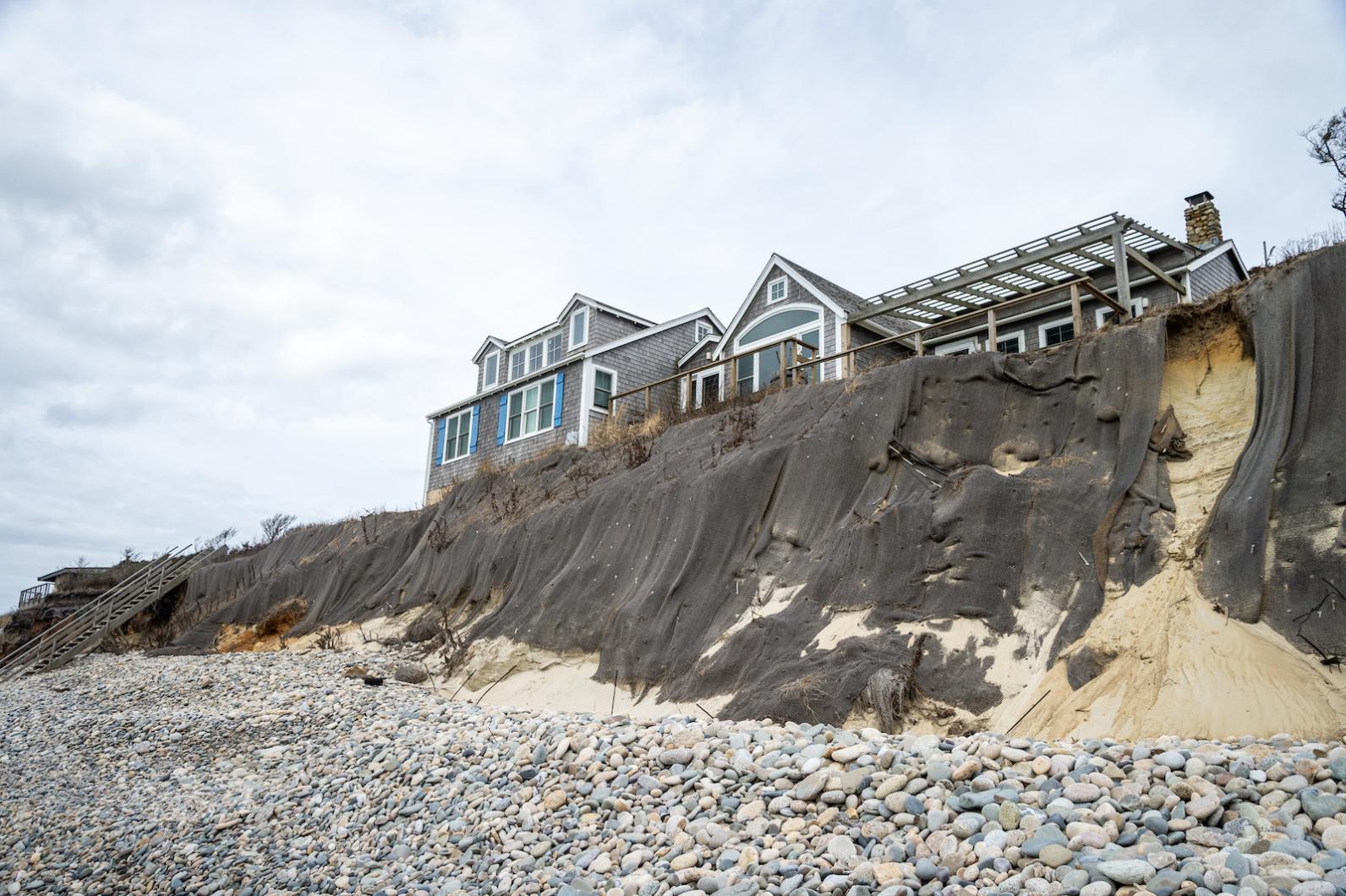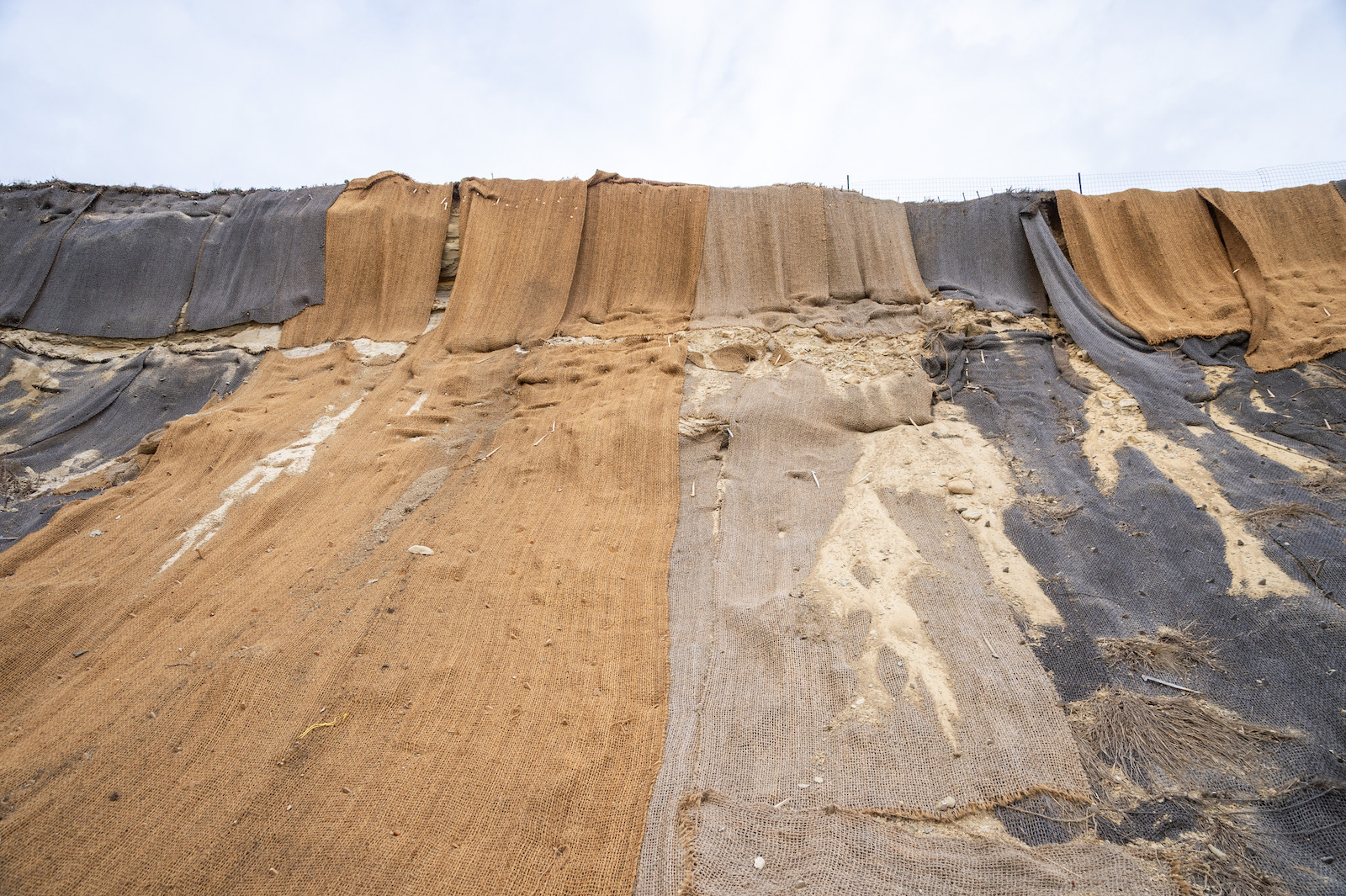Restrictions on a plan to move three homes away from an eroding cliff along Stonewall Beach have received a rocky reception from the property owners.
The Chilmark conservation commission late last month gave the owners of 8, 16, and 18 Greenhouse Lane permission to relocate their homes and bolster the deteriorating cliff in order to stave off the immediate threat posed by Mother Nature.
But, upset with what they consider burdensome limits on the plan, the homeowners have filed an appeal to the state Department of Environmental Protection, according to their lawyer.
“The Petitioners are not challenging the approval of the Project, but only the Commission’s inaction and the illegal and inappropriate Special Conditions imposed,” attorney Caroline Smith wrote in one of the appeals.
The application, filed by owners Jodi and Paul Darrow, Joel and Marcy Greenberg, and Larry Rockefeller, is one of the largest that has come before the conservation commission in recent memory, spanning at least seven public meetings and hours of discussion.
Each homeowner asked to move their home back as their individual property allows, and they planned to together reinforce the rocky slope down to the water.
The shoring up of the approximately 400-foot of the beach was planned to start with the installation of 20-inch wide fiber rolls at the foot of the beach. Such rolls are commonly used around the Cape and Islands to stabilize soil.
About 10 rolls are planned to be stacked on top of each other, and then would be covered in stones. The homeowners also planned to regrade the slope and plant beach grass and other vegetation to firm up the cliff.
The plan was a departure from the initial proposal, which would have put wire baskets filled with rocks towards the base of the beach. That raised alarms for some commissioners and was pulled in March.
Other aspects of the plan have also changed. The Darrows, whose home at 18 Greenhouse Lane is only a foot or so away from the edge, originally hoped to build a new foundation further back on the top of the cliff.
Now, they are planning to move the first floor of their existing house and place it on piers with a walkout basement about 25 feet back from the edge.
Eight Greenhouse Lane, the easternmost property, is going to be moved about 100 feet to the north and slightly rotated. Sixteen Greenhouse Lane will be pushed back about 55 feet.
All three of the existing homes’ foundations will be demolished and filled in, according to the plans.
During the April 22 meeting, the commission, which oversees the enforcement of town and state wetland rules, set several limits on the projects and added triggers that would require more action from the owners.
If a named storm or a storm with high sustained winds blows in, the owners must conduct an inspection of the site to check for damage. The commission also asked for an annual report with pictures near the edges of the work to see if the project was causing any issues with neighbors.
If the fiber rolls are exposed to a certain degree, the homeowners will be responsible for covering them again with sand.
During construction, any debris must be removed from the properties at the end of the work day or put in covered dumpsters to prevent construction detritus from blowing into the water or nearby wetland.
Access for construction equipment could only come in from 8 Greenhouse Lane, and the relocation plan will also need to get approval from the town board of health.
The Darrows’ home generated the most discussion, as it is the closest to the bluff, and can only move so far back because it is bordered by a wetland. The conservation commission ordered the homeowners to put up boulders every 10 feet along the marsh border to protect the wetland.
Sarah Khedouri, the chair of the conservation commission, said the conditions imposed on the project were based on the need to head off any environmental threats. Advice was sought from experts at state agencies, including the Massachusetts Office of Coastal Zone management, she added.
“We’re obliged to make findings under the state Wetlands Protection Act about whether the proposed construction would threaten the natural resources, such as the coastal bank, coastal beach, coastal dune and wetlands (in this case a Marsh flowing into Stonewall Pond),” Ms. Khedouri wrote in an email to the Gazette on Sunday.
The homeowners are challenging the conditions, in part, based on how long it took the commission to get its decision to the applicants. According to Ms. Smith, the town has 21 days after closing a public hearing to get its order of conditions to applicants.
The public hearing for the Stonewall homes closed on April 3, giving the commission until April 24 to get the order to the homeowners. After voting on April 22, Ms. Smith wrote that the conservation commission agent reached out to the homeowners’ engineer on April 24, saying the order was ready to be picked up at town hall.
The engineer wasn’t available that day and picked it up the following day, outside the 21-day deadline, Ms. Smith claimed.
The applicants also challenged the conservation commission’s restrictions on the type of septic system, contending that the slope the homes are on isn’t a dune, which would necessitate other requirements, and felt that the need to inspect the property after sustained winds of 40 miles per hour was too stringent.
“It is common for sustained winds to exceed the 40 mph threshold or for winds gusts to exceed 58 mph on Martha’s Vineyard,” Ms. Smith wrote. “Petitioners anticipate these triggers will be met frequently, and would require mobilization of a full survey crew when no topographical change from erosion has actually occurred.”
Several other limits, including the access point for construction, were under contention in the appeal, and the homeowners have asked for them to be struck down by the DEP.
The Darrows’ house did not have unanimous support when the conservation commission came to a vote.
Member Chris Murphy was against the relocation of the home, arguing that even with the protections it could be harmful to the environment.
“We all know this house should not be moved to a new location on this lot,” he said. “It’s time to say no, it’s enough. If we don’t do that, we are not doing our job.”
Others thought that such an approach could provoke a lawsuit from the homeowners and endanger the rest of the plan.
“I think it’s an invitation for litigation,” said member Stephen Kass. “I think it raises a question as to whether the other two applicants would do the entire shore protection plan.”
In the end Mr. Murphy was outvoted 6-1 and the Darrow relocation was approved. The rest were approved unanimously.








Comments (10)
Comments
Comment policy »